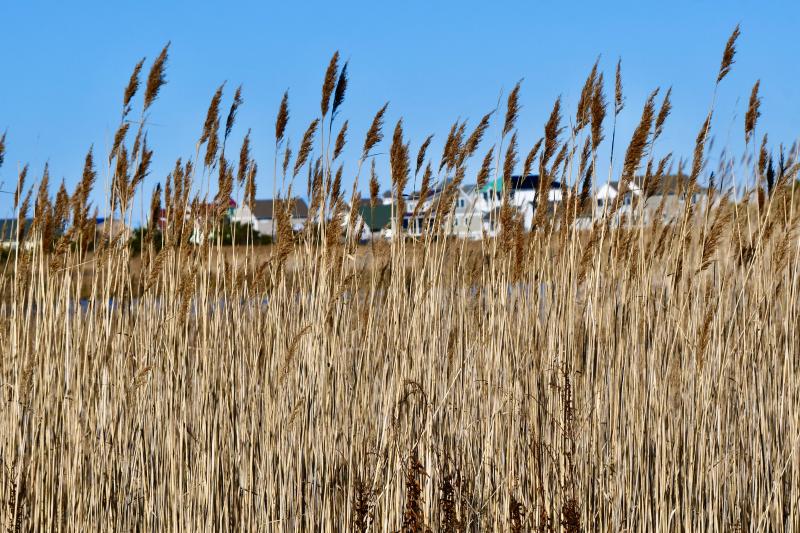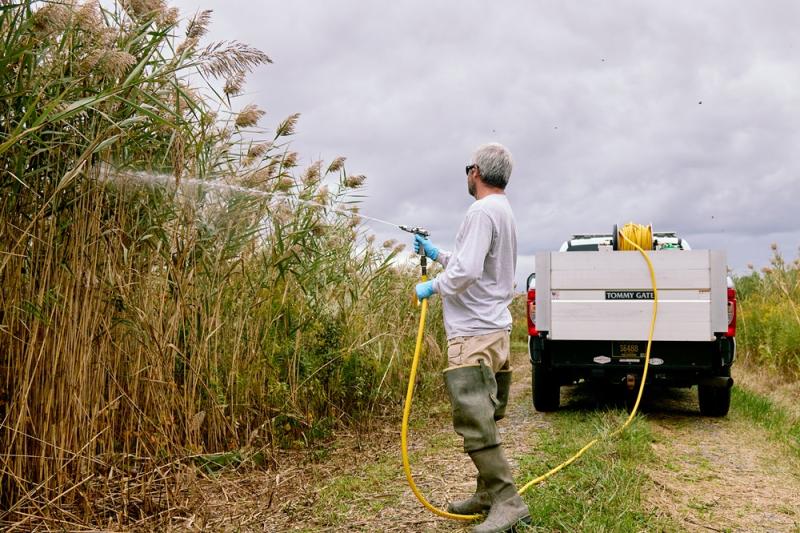Sussex County’s marshlands are at times inundated by an invasive plant that’s hard to get rid of – phragmites.
It’s a wetlands-based plant also known as the common reed. The species grows up and down the state, though it is primarily concentrated near the coast. It grows worldwide in brackish and freshwater marshes, at the edges of ponds, lakes and ditches, and in dune systems on barrier islands.
There is a strain native to the area, but most of the phragmites in the state are invasive, and they threaten to disrupt native habitats, leeching nutrients away from long-established plant species that many local animals rely on.
“Phragmites, when left unchecked, will completely take over a marsh,” said Jamie Joachimowski, an impoundment/habitat biologist who runs the phragmites program within DNREC’s Division of Fish and Wildlife. Joachimowski sprays stalks of phragmites with chemicals using his truck-mounted unit.
According to the Delaware Department of Natural Resources and Environmental Control, phragmites have reduced native plant, fish and wildlife diversity along waterways like the Delaware Bay and Delaware River.
About phragmites
Invasive species, by definition, outcompete native variants, disrupting ecosystems in the process. Many animals that used phragmites for food or nesting have been adversely impacted by the spread of the invasive species, which tends to grow taller and in more densely packed clusters than the native variety.
“The non-native is pushing out the native species because it’s so darn aggressive,” said DNREC botanist Bill McAvoy.
The invasive strain is believed to have been introduced from Europe to the United States in the early 19th century after it was used as packing material. It was first identified in the Philadelphia area and by the 1840s had made its way to Delaware, McAvoy said.
Today, the native phragmites type is much rarer than its foreign counterpart. The non-native species grows in both fresh and salt water, whereas the native variant prefers less-salty water. In addition to the height and how densely packed together the plants are, an observer can tell the strains apart by the color and texture, with the invasive variety being a darker green and possessing a rough, ridged stem.
Controlling phragmites
The state has been working actively to control the reed since the 1940s, with the General Assembly declaring it a nuisance plant in 1984.
For the past 40 years, DNREC has offered a cost-sharing program to fund the removal of phragmites, partnering with the U.S Department of Agriculture’s Natural Resources Conservation Service to run an initiative known as the Delaware Phragmites Control Cost-Share Program. This program benefits Delawareans by treating phragmites on both public lands like wildlife areas and private property at the owner’s request, with the landowner and government splitting the cost.
DNREC focuses on habitat restoration, aiming to manage the phragmites population and thus allow other flora – and, as a result, fauna – to thrive in wetlands.
Joachimowski, who until recently was the program’s sole employee, is responsible for overseeing phragmites control throughout the state. Using herbicide, he arranges for sprayings to occur when and where they are needed. Generally, large patches on public lands are sprayed every few years to keep the plant in check.
Joachimowski keeps in touch with overseers of wildlife areas and related properties throughout the state so he can stay abreast of where phragmites are growing in large quantities. The goal is to treat about 3,000 acres a year between state and private properties.
Sprayings only take place from August to October. Phragmites begins flowering in June, meaning efforts to eliminate members of the species with chemicals before then will not reach into the plant’s root system, which will simply lead to it growing back the following year.
DNREC typically uses the chemical herbicide glyphosate, which is usually applied from a helicopter hovering roughly 30 feet above the ground. The sprayers are able to cover within a matter of minutes areas that would take a person on foot days to manually spray.
For areas of less than a quarter-acre, as well as touch-ups after a helicopter visit, Joachimowski will go out and spray up close from his truck-mounted unit. Once sprayed, phragmites in an area will typically be kept in check for a few years, at which point another helicopter flyover might be arranged to kill off new growth.
“It’s not really a necessity to spray every bit every year. We’re trying to continuously work on it every year to keep it under control, to keep it from reverting back to 100% phragmites cover,” Joachimowski said.
Public and private land
Of the 3,000 or so acres DNREC sprays each year, about a third to half are on private land.
DNREC recommends landowners start the application process a year in advance. With spraying only occurring a few months out of the year, property owners are sometimes left waiting due to not completing the paperwork in time. Depending on available state funding, Joachimowski has the ability to offer financial assistance directly to Delawareans to cover that initial one-year gap.
Once enrolled, a property will receive spraying for three consecutive years. Delawareans must have between five and 200 acres of phragmites to qualify, and such lands must be accessible to aerial treatment. Tax ditches are not eligible for the program.
Counting both public and private lands, Joachimowski sprayed more than 60 parcels in 2024.
While landowners will sometimes contact DNREC about having phragmites removed for aesthetic reasons, the agency is concentrated on habitat restoration. In such a situation, Joachimowski will suggest the landowner reach out to a private company or handle the work themselves. DNREC does offer some do-it-yourself phragmites control tips, available at tinyurl.com/y3ys5usj.
While phragmites disrupts habitats, it also can play a role in erosion protection, so Joachimowski will direct the helicopter pilot to leave certain coastal areas alone to allow the species to strengthen dikes and levees.
PHRAGMITES FACTS
Can grow as tall as 13-14 feet
Can spread up to 4 feet per day
Invasive species probably came on ships from Europe in the 1800s
Of the 3,000 or so acres DNREC sprays each year, about a third to half are on private land




















































